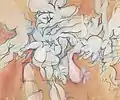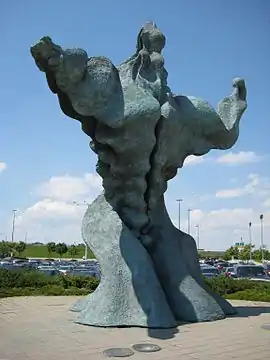Gerald Gladstone
Gerald Gladstone RCA (7 January 1929 – 7 March 2005) was a Canadian sculptor and painter.[1]
Gerald Gladstone | |
|---|---|
| Born | 1929 Toronto, Ontario, Canada |
| Died | 2005 Toronto, Ontario, Canada |
| Education | Royal College of Art |
| Known for | sculptor and painter. |
| Movement | figurative sculpture |
| Awards | elected member of the Royal Canadian Academy of Arts in 1974 |
Life
Born in 1929 in Toronto, Ontario, Canada to Ralph and Dora Gladstone, Gerald was the sixth of nine children. In his youth, Gladstone was as committed to music as he was to painting, teaching himself to play the clarinet and forming a jazz band.
He married in his early twenties supporting his young family with a variety of jobs ending up with a position in commercial advertising. He set up a sculpture studio and began working on a series of welded pieces influenced by Constructivism. In the 1950s, Gladstone was exhibited by Toronto gallery owner Av Isaacs along with artists such as Michael Snow, Gordon Rayner, Graham Coughtry, and Tony Urquhart.[2][3]
His works can be found in public spaces and prestigious galleries throughout Canada, the United States and internationally. He was widely recognized for his contributions to modernist sculpture and abstract painting during the mid-20th century.
Gladstone's unique approach was characterized by the use of bronze and steel to create highly abstract and geometric forms. His work often explored themes of time, space, and the dynamics of human perception. He also showed an interest in astrophysics and the concept of universal structures, which reflects in his artwork. Gladstone and Buckminster Fuller crossed paths in the artistic and academic circles in the mid 1960s and became lifelong friends. Buckminster Fuller (often referred to as “Bucky”, July 12, 1895 - July 1, 1983) was an American architect, systems theorist, author, designer, inventor, and futurist. Fuller, best known for popularizing the geodesic dome, philosophies on design and sustainability greatly influenced 20th-century art, architecture, and science. Gladstone was friends and influenced by their shared interests in design, space, and geometric forms.
The relationship between Gerald Gladstone and Buckminster Fuller's shared interests provided a solid foundation for their strong friendship. The mid-1960s were a period of intense creativity and innovation in the arts and sciences, and cities like Toronto, New York, Chicago, Los Angeles, and Montreal, were vibrant hubs of activity. Their friendship was influential; Fuller's principles of "doing more with less" and "design science revolution" would have resonated with Gladstone. Fuller's futurist thinking and focus on the intersection of art and science resonated with Gladstone's own explorations of astrophysics and universal structures in his work. This connection between Gladstone and Fuller further underscores the interconnectedness of the arts and sciences and the important role of interdisciplinary friendships in fostering innovation and creativity.
In 1959, Gladstone received his first Canada Council of the Arts grant and relocated to London, England. He studied at the Royal College of Art where he met and befriended the British sculptor Henry Moore. Under Moore's influence, Gladstone began a long period of experimentation with figurative work.[3]
In 1967, Gladstone received three commissions for Montreal's Expo 67. There was an exhibition of his mid- to late-career plastic cube sculptures and his Downtown Nudes Series - a collection of oils on canvas - at the opening exhibition of Toronto's St. Lawrence Centre for the Arts, and in 1973 he produced the Electric Figure Series, another collection of oils on canvas. Among his later-career commissions were the Three Graces, a fountain and bronze sculpture for the Ontario government buildings, Female Landscape, a fountain and bronze sculpture at Montreal's Place Ville Marie, Optical Galaxy Sculpture, a fountain and sculpture in Belconnen, Australia, and in 1978 a fountain and precast concrete sculpture for a Martin Luther King Jr. memorial in a Civic Center plaza in Compton, California.[4] The sculptures in the entrance of La Ronde in Montréal Québec Canada are made by Gladstone. Other works include:
- McGillivray Fountain 1968, Exhibition Place, Toronto
- Pylon 1960, 170 Memorial Park Avenue, Toronto
- Solar Net 1963, Larkin Building (University of Toronto St. George Campus) Devonshire Place, Toronto
- Galaxy Series Number2 1967, inside Macdonald Block, 900 Bay Street, Toronto
- Female Landscape 1972, Place Ville Marie, Montreal
In 1990, Gladstone set up a studio in Beaverton, Ontario.[2][5] The Art Gallery of Ontario held a retrospective of his work in 2003. He was made a member of Royal Canadian Academy of Arts[6] Gladstone died on March 7, 2005, in Toronto.[5]
Works
 Gladstone's The Three Graces, fountain & sculpture, 1972, Macdonald Block (Ontario Government Buildings) 900 Bay Street, Toronto
Gladstone's The Three Graces, fountain & sculpture, 1972, Macdonald Block (Ontario Government Buildings) 900 Bay Street, Toronto Gladstone's Downtown Nudes, oil on canvas, 1970s
Gladstone's Downtown Nudes, oil on canvas, 1970s Gladstone's Universal Man, sculpture, 1976, Yorkdale Mall, Toronto
Gladstone's Universal Man, sculpture, 1976, Yorkdale Mall, Toronto
 Gladstone's Galaxy at Cameron Offices, Town Square expresses humanity's concern with its position in intergalactic space, Canberra ACT, Australia
Gladstone's Galaxy at Cameron Offices, Town Square expresses humanity's concern with its position in intergalactic space, Canberra ACT, Australia Gladstone's Dr. Martin Luther King Jr. Memorial, 1978, in Civic Center Plaza of Compton, California
Gladstone's Dr. Martin Luther King Jr. Memorial, 1978, in Civic Center Plaza of Compton, California
Selected exhibitions
- 1967: Expo 67, Montreal[7]
- 2003: Art Gallery of Ontario, Toronto: Gladstone: Event Horizon
Selected collections
- National Gallery of Canada, Ottawa
- Art Gallery of Ontario, Toronto
References
- "Gerald Gladstone". National Gallery of Canada. Archived from the original on 28 September 2013. Retrieved 26 September 2013.
- Martin, Sandra (9 March 2005). "Gerald GLADSTONE, Artist: 1929-2005". Toronto Globe and Mail. p. S9. Archived from the original on 27 September 2013. Retrieved 26 September 2013.
- "Morning Flight - Gerald Gladstone". City of Windsor. Archived from the original on 27 September 2013. Retrieved 26 September 2013.
- "Dr. Martin Luther King, Jr. Memorial". Comptoncity.org. Archived from the original on July 24, 2010. Retrieved September 3, 2020.
- "Gerald Gladstone, Event Horizon November 8, 2003 to February 15, 2004". Art Gallery of Ontario. Archived from the original on 27 September 2013. Retrieved 26 September 2013.
- "Members since 1880". Royal Canadian Academy of Arts. Archived from the original on 26 May 2011. Retrieved 11 September 2013.
- "Two Canadian Sculptures at Expo 67". Sculpture International. Oxford: Permagon Press. 4 (1): 50–51. 1967 – via archive.org.
External links
- Gladstone, Bill. 'A sketch of artist Gerald Gladstone' November 29, 2011
- Toronto Sculpture - Virtual Gallery (Gerald Gladstone)
- Artnet.com (Gerald Gladstone)